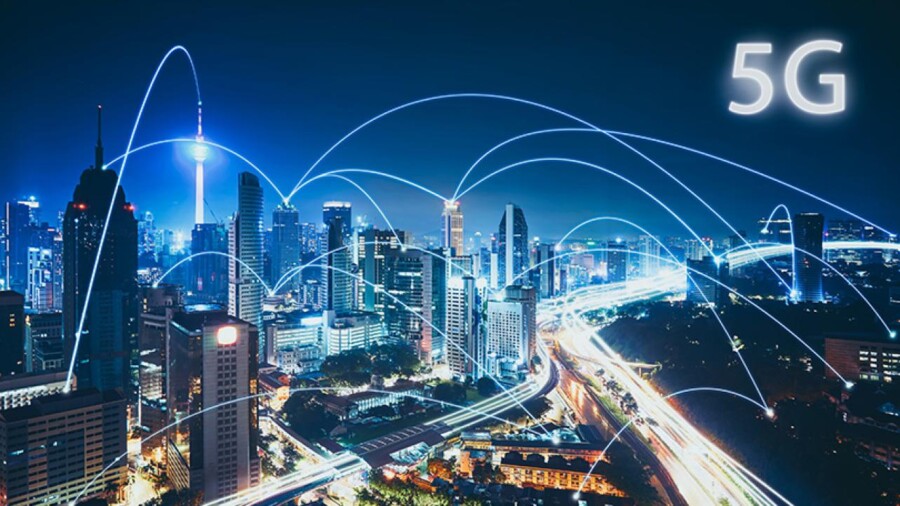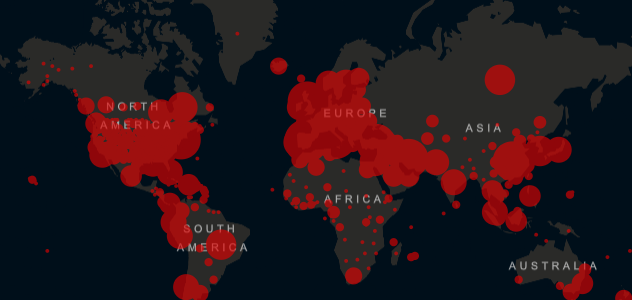The Geospatial Convergence: 5G and the Future of Wireless Technology

(Image Courtesy of PCMag)
All types of technology are constantly evolving in today’s fast-paced world, and wireless technology is no exception. 5G, the fifth generation of wireless technology, will soon be as ubiquitous in the real world as it is in tech writing. With the ability to move more data more quickly than previous generations of wireless tech, 5G will empower everything from smartphones to autonomous vehicles and smart cities. The technology is as capable of enabling a machine to quickly download plans to fix itself as it is loading a movie onto a phone.
Whether in New Delhi, New York City, or Newfoundland, geospatial data and information are crucial to 5G network rollouts. Well-planned, expansive networks are required for this technology to work seamlessly, because, along with its benefits, 5G brings a set of challenges that require detailed and dynamic geospatial data and information to solve.
5G waves are shorter and denser than those of 4G. They can be stopped by a hand, wall, or a palm branch in the breeze. A general rule-of-thumb for 5G connectivity is a line-of-sight from one antenna to another, meaning networks are built with more base stations, in closer proximity, than previous communication infrastructure. In rural areas, this will mean building new towers, while in urban areas, designers will attach antennas to existing buildings. This points to an instance of location data being crucial to the success of 5G; to install an antenna on existing structures, land ownership data will need to be considered.
Location data has already helped cities and communities build themselves in smarter ways. Using that existing information to implement 5G is a logical step, and GIS companies are providing both unique and existing data to the telecom industry. Geospatial analysis can go beyond physical details of cities and landscape; it can also provide insights on the people, weather, and vegetation that live in them. This data provides radio engineers and network designers a deep understanding of factors that could impede signal reliability. Consideration of things like pedestrian traffic, planned construction, seasonal plant growth, and even risk for natural disaster all adds to the stability of the 5G network. Seeing those factors in one geovisualized image is invaluable.
Existing land use and coverage maps give one part of the picture, while high-resolution data, such as LiDAR technology, which is already being put to use in autonomous driving can provide designers with real-time updates and hyper-detailed imaging of the city they are working in, even at different times during the day or across a period of time. If a distance between two base stations or antenna is too great or interrupted by a signal-blocking element, alternatives can be devised. LiDAR’s accuracy allows for these adjustments and tests to occur on virtual site visits and field simulations, which keeps costs, delays, and surprises at a minimum.
As 5G networks go live, geospatial data will help companies keep track of where signal strength falters. This gives them the ability to respond in real-time to the needs of their customers, while providing the data needed to address the problem at its root.
Key Takeaways:
- 5G networks require more antennae in closer proximity because its waves are shorter and more easily blocked than previous technology.
- GIS data allows designers and engineers to design and test networks around potential signal-blockers, no matter how small a factor they may seem. This ensures that the most reliable network is built the first time around.
- LiDAR’s ability to update maps and databases in real time and in great detail allows for a greater ability to react proactively to developments that may threaten network stability.
The Geospatial Convergence: How The Sports World is Embracing GIS Data For Strategy & Planning

(Image courtesy of The Atlantic)
In any domain, a strategic advantage is a prized asset. On fields of sport, especially at the professional level, where strength and skill are often equally matched, a strategic advantage can mean the difference between a winning record and a losing one.
Athletes, coaches, and team owners are finding ways to empower their missions with geospatial data. Some of their uses are to be expected, like tracking distances and speeds of runners or dogsled racers. Others are used to uncover hidden advantages.
One of the best examples of this is travel planning for teams. In general, the more a team travels, the more prone to injury their players are. In the 2015-2016 NBA season, for example, the most travelled team, the Golden State Warriors, reported more injuries than the least-travelled team that year, the Cleveland Cavaliers. With geospatial information aiding decision-making by league executives, this is the kind of problem that can be smoothed out league-wide, evening the competitive field.
Speaking of fields, a player’s activity on them during a given game or match can reveal much about their strengths. Detailed break-downs of an athlete’s habits and successes, like this one conducted by Esri for a match between Roger Federer and Andy Murray, can help hone specific skills. The data linked above, for example, combines court position, ball bounce, point outcome, and opponent responses to give an incredibly detailed analysis of what occurred.
In team sports, like soccer, that kind of information can be used to predict how opponents will react to a player in each in-game scenario. Coaches can use this information to add an element of psychological advantage to their strategies, by deploying players at advantageous moments. They can also use this to gain an accurate statistical picture of who the most valuable players are. These kinds of micro-data points lead to far more understanding of a good performance than mere point totals.
Of course, GIS data can be used to examine far more than a few individuals on a sports field. Team and league owners are using cross-referenced geospatial and population data to determine where to build stadiums, which stations to air games on, and even which cities to move teams to.
Finally, sports use the kinds of applications more traditionally associated with GIS in distance-based events, like the Tour De France and Iditarod, to track and map participants. This allows viewers worldwide to track their favorite participants in real-time. The more accurate the data, the more nuanced a picture of their performance we can see.
Key Takeaways:
- GIS data can help athletes and coaches with small-scale strategy and predictive models for opponent behavior, as well as their own.
- Leagues and owners use the information to ensure their teams play to the biggest and most enthusiastic markets.
- Non-athletic advantages, like a more moderate travel schedule, can be identified and mitigated, ensuring as fair a competition as possible.
The Geospatial Convergence: The Critical Role of Geospatial Data in Times of Humanitarian Crisis
Humanitarian crises come in many forms. But whether violence, water scarcity, famine, viral outbreak, or a natural disaster, they all share a common enemy: Geospatial data.
Crisis Management
In a humanitarian crisis, knowing the lay of the land is critical, especially for field teams coming from outside the affected area. The CDC’s field epidemiology manual even lists generating generic maps as a primary step in crisis response set-up.
Understanding natural and built environments is crucial for setting up operations and delivering supplies. Meanwhile, deeper data integration, like population data, helps determine need and aids logistics.
GIS data is already a proven necessity in matters of supply logistics, given its ability to cross-reference diverse data like weather, road closures and conditions, and population data.
This becomes increasingly important in areas where non-government actors control swaths of territory. When there are no ‘official’ sources to turn to, satellite imagery and heat mapping, not to mention cell phone use tracking tools, can shine light into information dark zones. This capability can help supplies from falling into the hands of agitators rather than helpers.
Post Crisis Evaluation
In the aftermath of a crisis, geospatial data helps tell the world what happened. A grim example – GIS data has been used to map unmarked execution sites and mass graves by cross-referencing soil readings and plant growth patterns from similar sites in the past.
In her 2018 speech to GEOINT, Linking the World CEO Mina Chang put forth a clear vision of ways the geospatial and big data industries can empower humanitarian causes. The results, she postulated, could help prevent crises from arising in the first place.
The Future of Crisis Management – Prevention
Right now, organizations react to events that occur and funding goes toward fixing the situation, which Chang says is similar to treating a symptom but not the underlying disease. With the predictive power of geospatial data, this is a paradigm that could shift toward crisis prevention, rather than crisis response. The captivating visual nature of interactive maps may also spur donations toward preventative measures – much the way images of disaster inspire people to support relief efforts.
Analyzing a story map like the one, or the WHO’s ebola map, provides an invaluable window into the spread of a virus. This data is now used as a teaching tool for those who must respond to the next humanitarian crisis. Data-rich models can, as Chang says, give helpers a look into the future by analyzing past human and viral behaviors over landmasses.
Current Day Use Case
GIS logistics planning is already being used to combat the spread of COVID-19.
On March 30, 2020 at Mayo Clinic’s Jacksonville, Florida campus, autonomous vehicles began delivering COVID-19 tests and medical supplies.
To address the current pandemic on a global scale, there are tools like Esri’s COVID-19 Tracking Dashboard, which provides data to researchers, governments, aid workers and the general public in real time.
Key Takeaways:
- In current day, the use of geospatial data during humanitarian crises is critical for proper evaluation, tracking and response
- When there are no official sources to turn to, different forms of geospatial data, such as satellite imagery and population data, can be your only source of truth
- The focus needs to shift from humanitarian response to humanitarian prevention. By leveraging the ever-expanding geospatial databases and the many tools available, this vision of crisis prevention could become reality
- Interactive web-based maps can be an incredible tool for educating the world about the crisis whether that is real-time tracking or post-crisis evaluation and fundraising
Image Courtesy of Johns Hopkins University.
The Geospatial Convergence: How Autonomous Vehicles Rely on Geospatial Data To Safely Navigate From A to B
Drivers need maps to get where they’re going. As cars learn to drive by themselves, they’ll need maps, too.
As transportation responsibilities transfer from humans to machines, clear, reliable data is essential. A human can differentiate between a map and its surroundings, but to the Artificial Intelligence running autonomous vehicles, the map data is their world. The more data-rich the map, the safer the vehicle’s cargo, whether commercial or human. Standard maps cannot give daily updates on construction zones or changes in laws and driving regulations, but maps powered with specific geospatial data can. Even information like parking ramp usage can be used to improve the user’s experience. The geospatial information industry, with its diverse data handling ability, is poised to empower autonomous vehicles to take the wheel.
Some of the largest companies in the world are making investments with an eye toward the coming autonomous vehicle boom. Amazon’s recent heavy investment into companies like Rivian and Aurora comes alongside a commitment to begin electric vehicle delivery by 2021. In the automotive industry, companies like BMW are making sure their big data departments, which are used to further the pursuit of autonomous cars, are staffed with geospatial data experts.
The future they are preparing for is coming fast. In late 2019, a Plus.ai self-driving truck transported a load of Land O’ Lakes butter from California to Pennsylvania (2,800 miles). () It navigated the entire stretch of I-15 and I-75 all on its own, without a single intervention from the onboard safety driver.
Interstate trucking routes are typically predictable, long, straight stretches of highway. For a more dynamic environment, enhanced detection and imaging abilities are required. Self-driving passenger cars need to know the size, shape, and position of unexpected obstacles. And they need these details regardless of the weather. Enter: LiDAR.
Light Detection and Ranging, or LIDAR, gives cars a 360 degree, 3D image of their environment, using laser beams to define its surroundings. They usually take the form of a cylinder on a car’s roof. Today, units are capable of 1.3 million readings a second to create an image. While radar beams detect things over a broad swath to determine weather or large obstacles, LiDAR can define things down to a shirt button.
As cars drive around with LiDAR sensors, terabytes of information are generated. This scanning data can be used in pursuit of better mapping information. And, in turn, existing geospatial data can also help determine the accuracy of labels generated by AI.
Once the new data is organized, test divers of self-driving cars are sent back out with a new combination of scenarios, synthetic data, and machine learning algorithms. Then the cycle begins again.
It may seem strange, but cars are about to have the same real-world expectations of what maps must convey as we do.
The Geospatial Convergence: The Many Applications of Geospatial Data in the Insurance Industry
At the nexus of insurance and geospatial information sits an important commodity: trust. People and businesses turn to insurers for protection in the event of a disaster. In turn, insurers look to reinsurance to protect themselves. In this swirl of individual policies, claims, disasters, and shifting populations, geospatial data brings clarity and actionable insights. For an industry operating on both global and local scales, the ability to track regional trends and apply them to individual policyholders has proven indispensable.
From health insurance to risk analysis, event monitoring to route planning, the insurance industry uses GIS, Satellite Imagery and various other geospatial inputs and technology to go beyond static figures and spreadsheets. The clearest examples may be with risk assessments where geospatial technology is leveraged to better assess risk across time and space.
For example, in an area affected by frequent power outages, insurers can use past outage trends to predict where future ones might occur, down to individual buildings utilizing GIS. This allows for a more strategic policy offering, tailored to the specific risks of an area. Geological data can be used to evaluate earthquakes and natural risk hazards, determining whether a repeat catastrophe in that area is likely.
The same goes for crime – home insurers can integrate their location information with that of the nearest police station’s activity, giving a clearer picture of the pattern of crime. Property values can be folded in, too, by linking with real-estate marketplace services.
The one commonality amongst all the various use cases in the insurance industry is the demand for accurate and constantly updated data. East View Geospatial is the sole provider of one of the best tools on the market, the LandScan Global Population Database. Developed by the Department of Energy’s Oak Ridge National Laboratory, LandScan is the industry standard for global population distribution. It is the world’s most accurate spatially referenced ambient population distribution model and features the finest resolution global population database. This provides insurers with critical location-based insights. The database is updated annually reflecting improvements in source inputs and algorithms. What does this mean for insurers? Quick and simple assessments, estimates, and visualizations of populations at risk.
Population data like LandScan is extremely valuable to the health insurance industry, too. In places that require health insurance, city officials can use GIS to pinpoint areas of low coverage within a city, even making predictions based on factors like income, health, and age. This is more than just a benefit to insurers – the refining of risk factors helps identify areas where the population may be more susceptible to an outbreak or specific illness.
Customer service-wise, the heightened ability to anticipate the aftermath of a disaster based on past events, while simultaneously following events in real time, gives insurers the capability of immediate action. Using imagery and geospatial data means customers can get their claims faster, and recovery can get underway sooner. With the power of objective geospatial data behind that decision-making, the outcome can be trusted, not contested.






